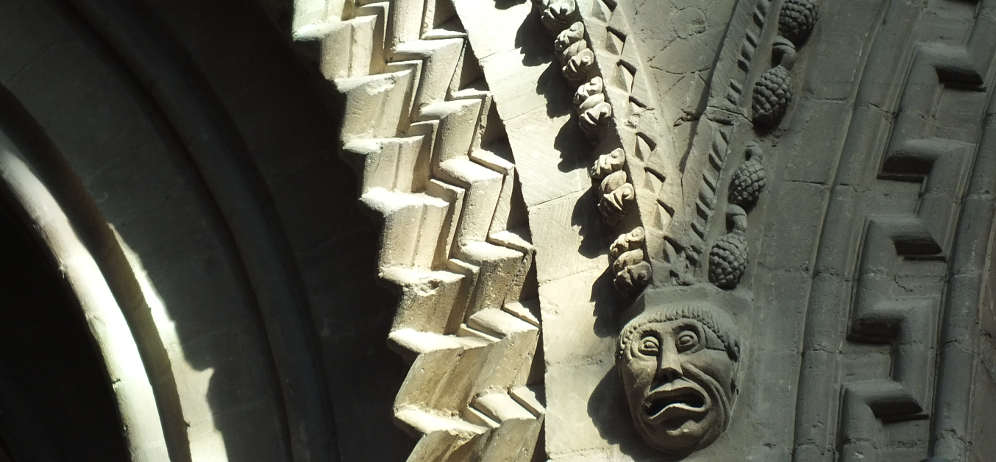About-France.com
- the thematic guide to France
Bayeux - a small town with plenty to see
| On this page | Location and access | Sites and attractions |
| In the area | Where to stay |

A scene from the Bayeux tapestry - the Norman cavalry at the Battle of Hastings, 1066 AD

And the just discovered final frame, predicting the 2025 Tour de France's departure from the town ! (with thanks to AI)
.
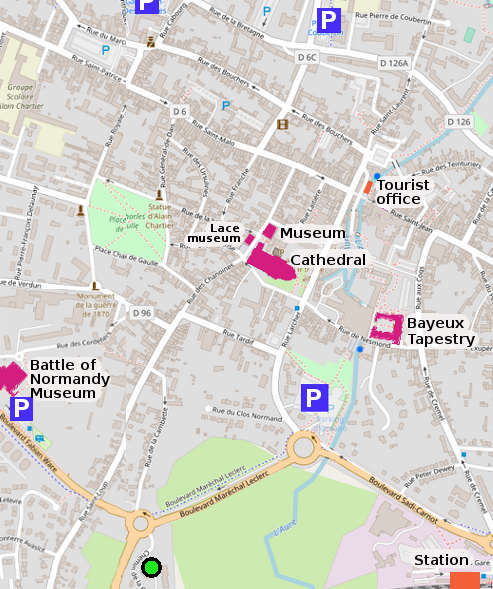 Bayeux,
the old town.
Parking. There is free unrestricted on-street parking away from the
centre. The Parking areas indicated at the top of the map are Free. The
parking area indicated closest to the Tapestry is a short-stay paid
parking area (up to 3 hours). There is free parking on the boulevards
Leclerc and Carnot, and near the station.
Bayeux,
the old town.
Parking. There is free unrestricted on-street parking away from the
centre. The Parking areas indicated at the top of the map are Free. The
parking area indicated closest to the Tapestry is a short-stay paid
parking area (up to 3 hours). There is free parking on the boulevards
Leclerc and Carnot, and near the station.The tapestry, which is almost 70 metres long, was not actually made in Bayeux. Most historians believe that it was made in England, for Bishop Odo, William the Conqueror's half brother. Like most important Normans at the time, Odo had lands and power in both England and Normandy. Odo was Earl of Kent and regent of England, as well as being Bishop of Bayeux.
Amazingly preserved for a tapestry that is over 900 years old, the Bayeux Tapestry has been in Bayeux ever since the late 11th century – a remarkable story for a long piece of linen cloth decorated with wool. The tapestry is displayed in a dedicated museum in Bayeux, but it is just one of the attractions of this small Norman town.
A short History of Bayeux
Even before Roman times, there was a settlement on the west bank of the small river Aure, about 9 kilometres inland from the coast. The Romans stationed troops here and built up a walled city: Augustodurum, as Bayeux was then known, was one of the strongholds on or near the northern coast of mainland Europe, designed to protect Gaul from invasions or attack from seafaring Germanic invaders.The Roman ramparts survived in some form until the 18th century, and it was on the site of the Roman town that medieval Bayeux sprang up. What remained of the Gallo-Roman town was sacked in the year 890 AD, when marauding Vikings came down from Scandinavia. The Vikings conquered the local population and settled along this part of the north coast of Gaul, which became known as the land of the North Men, i.e. Normandy, the land of the Normans.
When the power of the Dukes of Normandy
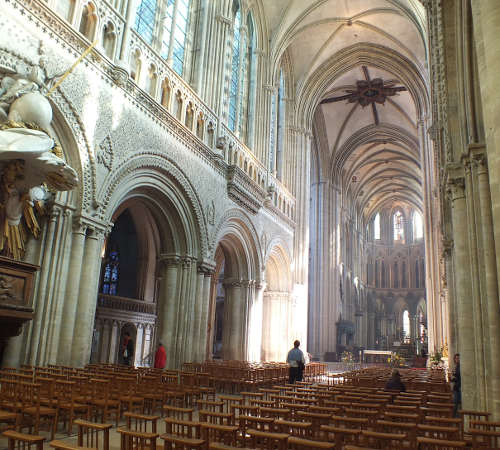
The Norman - gothic interior of Bayeux Cathedral.
During the Hundred Years War (1337 - 1453) the English Angevins tried to regain their historic lands in Northern France, and Bayeux was for a short time once more a possession of the king of England, Henry V. But in 1450, the town was taken by the French again, and has remained French ever since. For much of the time since then, Bayeux, with its cathedral and monasteries, has been a prosperous small city.
Miraculously, the historic city came through the Second World War fairly unscathed, while nearby Caen was devastated; on 14th June 1944, Bayeux was the first French city to be liberated by Allied troops advancing south from the Normandy Beaches.
Attractions and monuments in Bayeux
- Bayeux cathedral. The cathedral has been much extended and embellished since it was first consecrated in the year 1070. However, the massive Norman arches of the original building, with their geometric patterns, will look familiar to anyone who knows the great Norman cathedrals of England, such as Durham or Gloucester.
- The Bayeux Tapestry. The world's largest historic tapestry, sewn around the year 1070, and telling the story of the conquest of England by William the Conqueror, in 1066.
- The Baron Gérard Museum. Located in the historic former Bishop's Palace, Bayeux's main museum tells the history of Bayeux from prehistory to today. It has a substantial collection of historic porcelaine and lace, and art mostly from the 18th and 19th centuries, including works by Corot, Caillebotte and Philippe de Champaigne.
- The Lacemaking museum. Bayeux was a historic lacemaking centre, and the lacemaking museum tells the story of this cottage industry
- The Battle of Normandy museum Museum dedicated to the story of the Normandy landings and the advance of Allied troops into France in 1944.
- The old town. The centre of historic Bayeux has many old houses, including medieval half-timbered houses and other historic buildings. Don't miss rue Saint Martin, rue Saint Jean, rue de Saint Malo and rue Franche; and discover the old waterwheels beside the river Aure (blue dots on the map).
- The tourist train. The tourist train takes visitors on a commented circuit through old Bayeux. Departure from outside the Tourist information office
- The British military cemetry - the largest Second-world-war British military cemetery in France, 4 km from the centre of Bayeux.
► For more on Bayeux and its area, visit the Bayeux-Bessin tourist information office
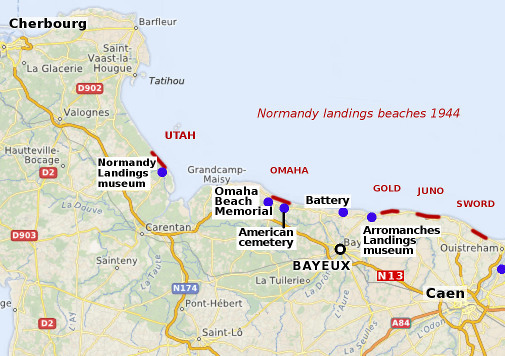
Bayeux, the Normandy
beaches, and the main museums and memorials
1. Sites associated with the Normandy Landings 1944
Bayeux is the departure point for many guided tours of the Normandy Beaches. For guided tours check out at the Tourist Office. Alternatively, one can visit the many sites and memorials of the Normandy Beaches by car or by bicycle, at one's own speed. There are a large number of memorials and museums large and small on the coast between Utah Beach and Ouistreham. The map and the list below show some of the principal locations and sites to visit.- The Normandy beaches and landings.
- The D-Day museum in Arromanches
- The Overlord museum, Omaha beach, located on the D514 near the American cemetery
- The Normandy American cemetery at Omaha Beach
- The battery at Longues sur Mer. The only surviving gun-emplacement from the German Atlantic Wall sea defences - with 4 big guns still in place.
- The Normandy landings museum at Utah Beach
- The Pegasus Bridge memorial at Ouistreham
- the German military cemetery at La Cambe, southwest of Omaha Beach
- The Ranger memorial at Pointe du Hoc, northwest of Omaha Beach
- The Airborne Museum at Sainte-Mère l'Eglise, near Utah Beach
- The Caen Memorial and museum. More than just a memorial to those who fell in the Second World War, this is a memorial to the violence and conflicts of the 20th Century
Other sites near Bayeux
- The Château-fort at Creully - a historic fortified castle 15 km east of Bayeux
Further afield (up to 120 km ... )
-
Mont Saint Michel, 120 km to the southwest. Built on a rock in Mont Saint Michel bay, this medieval city is one of the most visited monuments in France. ► For more info see Mont Saint Michel

Mont Saint Michel - Cherbourg 97 km to the northwest. The Cité de la Mer. Large maritime museum, including deep-sea diving, aquariums, and the Redoubtable, a decommissioned nuclear submarine.
- Honfleur, 87 km to the east. One of the prettiest historic harbours on the north coast of France. Popular with artists. Eugène Boudin museum. The 15th century St Catherines church is the largest old wooden church in France. ► See Honfleur
- La Suisse Normande. Hilly country 60 km south of Bayeux. Hiking and outdoor activities. The highest point is Mont Pinson, altitude 345 metres or 1,132 ft.
- By air The nearest airport is Caen,
- By train Bayeux can be reached by direct train services from Paris Saint-Lazare station, in just over 2 hours; and from Cherbourg in just under an hour. Tickets can be bought online at Trainline.com .
- By car Bayeux is under 3 hours from Paris., and in 35 minutes from the Channel ferry port at Caen / Ouistreham (services from Portsmouth - see Brittany Ferries)
Copyright
© About-France.com except where otherwise stated.
About-France.com
Home
page - Site
search
- Regions
- Maps of France
- Contact
Photo top of page : details of Norman Romanesque decoration in Bayeux
cathedral
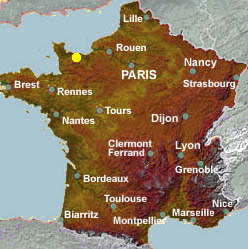
Hotel le Tardif
Luxury accommodation - rooms & apartments - in 18th century chateau close to Bayeux Tapestry museum. Free parking.
★★★ Hôtel Bayeux
Three-star hotel located 400 metres from Tapestry museum and from Cathedral. 10 minutes walk from train station. Free parking
★★ Hotel Reine Mathilde Between the Cathedral and the tourist office. Well rated traditional two star hotel with restaurant & free parking.
★★ Hôtel Le Mogador Reasonably priced traditional two-star hotel 700 metres from the Cathedral. Free public parking. Bike hire. Restaurants close by
★★★ Hôtel Campanile Bayeux
Three-star hotel located 500 metres from the Battle of Normandy museum. Green spot at the bottom of the map. Free parking
★ Hôtel Première Classe Bayeux
Cheap 'n' cheerful one star hotel located 500 metres from the Battle of Normandy museum. Green spot at the bottom of the map. Free parking

Old water-wheel, near the Tapestry museum
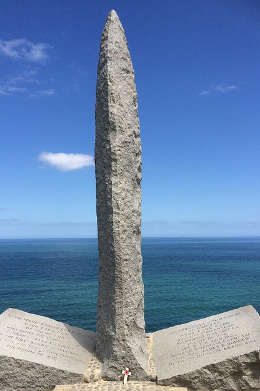
Ranger Memorial at Pointe du Hoc
Copyright texts and photos © About-France.com 2003 - 2025
Except:
Photo Pointe du Hoc by Joris1944
Photo Mont Saint Michel by JacLou
Maps enhanced from an open-source original by Openstreetmap. org
Key
tourist information for Bayeux:
Region: Normandy - northwest France.
Nearby cities: Caen, Rouen, Cherbourg
Nearest airports: Caen, Rennes, Paris CDG.
Distance from Paris: 265 km (165 miles)
Population: 13,600
Main sites: Bayeux Tapestry museum, the Cathedral, the Baron-Gérard Museum, the Battle of Normandy museum .
Nearby attractions and sites: The Normandy beaches, La Suisse Normande..
Region: Normandy - northwest France.
Nearby cities: Caen, Rouen, Cherbourg
Nearest airports: Caen, Rennes, Paris CDG.
Distance from Paris: 265 km (165 miles)
Population: 13,600
Main sites: Bayeux Tapestry museum, the Cathedral, the Baron-Gérard Museum, the Battle of Normandy museum .
Nearby attractions and sites: The Normandy beaches, La Suisse Normande..

Where to stay
The About-France.com selection
Hotels for all budgets and all needs
Hotels for all budgets and all needs
Historic centre
Hotel le Tardif
Luxury accommodation - rooms & apartments - in 18th century chateau close to Bayeux Tapestry museum. Free parking.
★★★ Hôtel Bayeux
Three-star hotel located 400 metres from Tapestry museum and from Cathedral. 10 minutes walk from train station. Free parking
★★ Hotel Reine Mathilde Between the Cathedral and the tourist office. Well rated traditional two star hotel with restaurant & free parking.
★★ Hôtel Le Mogador Reasonably priced traditional two-star hotel 700 metres from the Cathedral. Free public parking. Bike hire. Restaurants close by
Just outside old centre
★★★ Hôtel Campanile Bayeux
Three-star hotel located 500 metres from the Battle of Normandy museum. Green spot at the bottom of the map. Free parking
★ Hôtel Première Classe Bayeux
Cheap 'n' cheerful one star hotel located 500 metres from the Battle of Normandy museum. Green spot at the bottom of the map. Free parking

Old water-wheel, near the Tapestry museum
| ►► Site guide |
| About-France.com home |
| Full site index |
| About-France.com site search |
| ►► Principal chapters on About-France.com |
| The
regions of France Beyond
Paris, a guide to the French regions and their tourist attractions.
|
| Accommodation
in France |
| Guide
to Paris Make
the most of your trip to Paris; attractions,
Paris hotels,
transport, and lots more.
|
| Tourism in France
The
main tourist attractions and places to visit in France - historic
monuments, art galleries, and more
|
| Planning
a trip to
France
Information
on things to do before starting your trip to France.
|
| Driving
in France
Tips
and useful information on driving in and through France - motorways,
tolls, where to stay....
|
| Maps
of France
Cities,
towns, departments, regions, climate, wine areas and other themes.
|
| The French way of
life
A
mine of information about life and living in France,
|
| A-Z
dictionary
of France Encyclopedic
dictionary of modern France
|
Click here for
low-cost car hire in France
low-cost car hire in France

Ranger Memorial at Pointe du Hoc
Copyright texts and photos © About-France.com 2003 - 2025
Except:
Photo Pointe du Hoc by Joris1944
Photo Mont Saint Michel by JacLou
Maps enhanced from an open-source original by Openstreetmap. org

